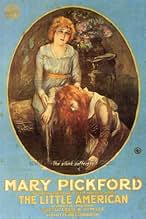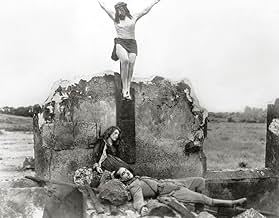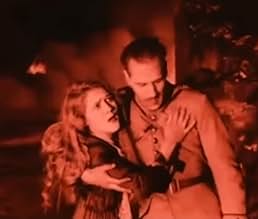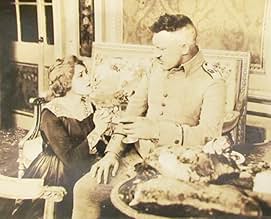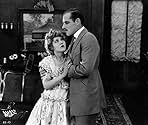Aggiungi una trama nella tua linguaA young American has her ship torpedoed by a German U-boat but makes it back to ancestral home in France, where she witnesses German brutality firsthand.A young American has her ship torpedoed by a German U-boat but makes it back to ancestral home in France, where she witnesses German brutality firsthand.A young American has her ship torpedoed by a German U-boat but makes it back to ancestral home in France, where she witnesses German brutality firsthand.
- Regia
- Sceneggiatura
- Star
Wallace Beery
- German Soldier
- (non citato nei titoli originali)
Olive Corbett
- Nurse
- (non citato nei titoli originali)
Lucile Dorrington
- Nurse
- (non citato nei titoli originali)
Clarence Geldert
- Submarine Commander U-Boat 21
- (non citato nei titoli originali)
Carl Gerard
- Reverend
- (non citato nei titoli originali)
Robert Gordon
- Wounded Soldier
- (non citato nei titoli originali)
Gordon Griffith
- Child
- (non citato nei titoli originali)
Recensioni in evidenza
According to his autobiography The Little American is the film that Cecil B. DeMille wanted to make with Mary Pickford. Both were strong supporters of the Allied cause in World War I. But Adolph Zukor wanted a box office draw with a western so A Romance Of The Redwoods was done first. DeMille envisioned The Little American as part of his contribution to the propaganda war effort. And Pickford was well known for her bond tours with her husband Douglas Fairbanks.
The Little American has Mary Pickford a daughter of the a US Senator and being courted by two men, German-American Jack Holt who receives orders to return to the Fatherland for an officer's commission in the newly declared war and French diplomat Raymond Hatton similarly ordered home. Pickford's family has a château in France and she travels there to be a nurse. But her ocean liner is torpedoed like the Lusitania and she eventually gets there.
But as it turns out the château is in German occupied territory and she's asked to do a little espionage. And who do you think is among the Germans occupying, none other than Holt.
As this was a film that DeMille himself labels a contribution to the war effort a lot of it can be dismissed. Pickford was her heroic best as The Little American. Some aspects of the real life Edith Cavell story are incorporated here with a lot more happy ending.
As for the German atrocities. They'd have to wait until the next war when Hollywood couldn't make up what they did in real life.
The Little American has Mary Pickford a daughter of the a US Senator and being courted by two men, German-American Jack Holt who receives orders to return to the Fatherland for an officer's commission in the newly declared war and French diplomat Raymond Hatton similarly ordered home. Pickford's family has a château in France and she travels there to be a nurse. But her ocean liner is torpedoed like the Lusitania and she eventually gets there.
But as it turns out the château is in German occupied territory and she's asked to do a little espionage. And who do you think is among the Germans occupying, none other than Holt.
As this was a film that DeMille himself labels a contribution to the war effort a lot of it can be dismissed. Pickford was her heroic best as The Little American. Some aspects of the real life Edith Cavell story are incorporated here with a lot more happy ending.
As for the German atrocities. They'd have to wait until the next war when Hollywood couldn't make up what they did in real life.
America entered World War One in April 1917 after almost three years of brutal fighting between England, France and their allies and Germany and its alliance. The first Hollywood so-called propaganda film released soon after Congress declared war on Germany and the Central Powers was Cecil B. DeMille's July 1917 "The Little American," starring Mary Pickford.
Its director DeMille had lost a good friend in the sinking of the Lusitania by a German submarine two years earlier, while Canadian Pickford had seen her native country involved in the war since 1914. Both were ardent supporters of the United States' war effort, and both eagerly participated in a movie that painted the Germans simply as barbarians. The Chicago Board of Censors, in fact, was so concerned about the city's large German-American population that it banned the movie from being shown. Two court rulings eventually overturned the censor board's prohibition from exhibiting "The Little American."
The Jeanne McPherson script does soften the anti-German edges somewhat by creating a young German residing in America as a paramour to Pickford. Karl Von Austreim, played by Jack Holt, is summoned by Germany in the fall of 1914 to join his regiment in Europe. The two lovers depart, only to once again meet on the battlefields of the Western Front. She's seen nursing several injured French soldiers after visiting her aunt in France, who had just died of natural causes near the fighting. Pickford ends up becoming a spy for the French, pinpointing important German artillery on her aunt's property. It is there she meets her old boyfriend, and he ends up becoming a protector for her.
While the film is praised for its recreation of a British liner's sinking by German hands, of which Pickford's character was a passenger, the movie failed to garner the enormous profits for the Mary Pickford Company, through its distribution branch Aircraft Pictures. This is the second and final picture DeMille directed with the popular actress. The first, released a couple months before in "A Romance of the Redwoods," was studio head Adolph Zukor's solution for a career correction for Pickford after viewing the preview of her last film, "The Poor Little Rich Girl." He saw the movie as being a total dud. Despite the actress having a clause in her contract giving her total control over her productions, Zukor felt DeMille's steady, serious hand would straighten her out. Of course "The Poor Little Rich Girl" ended up an enormous hit, and she would revert back to playing a kid again in her next two movies after "The Little American." To be fair, "Redwoods," on the basis of Pickford's star power, became the fourth highest grossing movie of the year.
Meanwhile, the two movies with DeMille spelled doom for her ongoing, unhappy marriage to actor Owen Moore, as well as making it easier in her clandestine romance with Douglas Fairbanks, whom she had met two years earlier at a Tarrytown, N. Y. party. The filming locations of "Redwoods" and "American" took place in southern California, where the married Fairbanks resided. Pickford had been living near her studio in Ft. Lee, N. J. before relocating out West. She would never live in the East ever again.
Returning to "A Little American:" Even a MacPherson script, co-written by DeMille, couldn't quite rescue "A Little American." MacPherson and the director formed one of the more successful and influential working partnerships in Hollywood. As an actress as well as a minor director and scriptwriter, she approached DeMille for an acting job in 1914. Instead, the director, realizing her scenario talents, hired her as a screenwriter. She went on to write 30 of DeMille's first 34 movie scripts, with her last screenplay for the director in 1930's "Madam Satan."
Its director DeMille had lost a good friend in the sinking of the Lusitania by a German submarine two years earlier, while Canadian Pickford had seen her native country involved in the war since 1914. Both were ardent supporters of the United States' war effort, and both eagerly participated in a movie that painted the Germans simply as barbarians. The Chicago Board of Censors, in fact, was so concerned about the city's large German-American population that it banned the movie from being shown. Two court rulings eventually overturned the censor board's prohibition from exhibiting "The Little American."
The Jeanne McPherson script does soften the anti-German edges somewhat by creating a young German residing in America as a paramour to Pickford. Karl Von Austreim, played by Jack Holt, is summoned by Germany in the fall of 1914 to join his regiment in Europe. The two lovers depart, only to once again meet on the battlefields of the Western Front. She's seen nursing several injured French soldiers after visiting her aunt in France, who had just died of natural causes near the fighting. Pickford ends up becoming a spy for the French, pinpointing important German artillery on her aunt's property. It is there she meets her old boyfriend, and he ends up becoming a protector for her.
While the film is praised for its recreation of a British liner's sinking by German hands, of which Pickford's character was a passenger, the movie failed to garner the enormous profits for the Mary Pickford Company, through its distribution branch Aircraft Pictures. This is the second and final picture DeMille directed with the popular actress. The first, released a couple months before in "A Romance of the Redwoods," was studio head Adolph Zukor's solution for a career correction for Pickford after viewing the preview of her last film, "The Poor Little Rich Girl." He saw the movie as being a total dud. Despite the actress having a clause in her contract giving her total control over her productions, Zukor felt DeMille's steady, serious hand would straighten her out. Of course "The Poor Little Rich Girl" ended up an enormous hit, and she would revert back to playing a kid again in her next two movies after "The Little American." To be fair, "Redwoods," on the basis of Pickford's star power, became the fourth highest grossing movie of the year.
Meanwhile, the two movies with DeMille spelled doom for her ongoing, unhappy marriage to actor Owen Moore, as well as making it easier in her clandestine romance with Douglas Fairbanks, whom she had met two years earlier at a Tarrytown, N. Y. party. The filming locations of "Redwoods" and "American" took place in southern California, where the married Fairbanks resided. Pickford had been living near her studio in Ft. Lee, N. J. before relocating out West. She would never live in the East ever again.
Returning to "A Little American:" Even a MacPherson script, co-written by DeMille, couldn't quite rescue "A Little American." MacPherson and the director formed one of the more successful and influential working partnerships in Hollywood. As an actress as well as a minor director and scriptwriter, she approached DeMille for an acting job in 1914. Instead, the director, realizing her scenario talents, hired her as a screenwriter. She went on to write 30 of DeMille's first 34 movie scripts, with her last screenplay for the director in 1930's "Madam Satan."
With the US having recently entered the First World War, the country's best known and most popular director teamed with its most beloved actress to fire a cinematic salvo in this flag-waving adventure.
In style this is something of a departure for DeMille. He more or less abandons his use of long takes, painterly shot compositions and predominantly visual narrative, in favour of rapid editing and lots of expository intertitles. Of course this is purely pragmatic it keeps the story moving along quickly and injects some excitement and tension into what is after all a propaganda piece. The heavier than usual use of intertitles also leaves no ambiguity about plot or character intention. Some of these editing patterns are quite effective for example, the crosscutting used when the ocean liner is torpedoed. However fans of DeMille's early silents will probably find themselves missing the more considered approach they will be familiar with. This is certainly one of his least graceful films.
The fact that The Little American is more action-centred means it is less acting centred there is not the same concentration on performance that you normally get with DeMille. For this reason this is not a particularly memorable role for Mary Pickford, and to be fair almost any actress could have played the part equally well. However the casting of Pickford would have been symbolic and psychologically effective at the time. Although the press had not yet labelled her America's sweetheart, she certainly occupied that position. Therefore DeMille did not have to go out of his way to endear the audience to the character of Angela Moore, because they had already formed an emotional attachment to Mary Pickford.
Regardless of how effective this picture was in its day it is really quite a mediocre effort when taken out of context. One interesting point though the one scene in The Little American that really looks like the typical DeMille is the one in which Pickford and Holt take refuge in a ruined church below the effigy of Christ on the cross. Throughout the picture the stars and stripes is treated with the same reverence and significance DeMille might give to a crucifix. This picture is another small step towards the iconic imagery and preachiness that would characterise his work from the twenties onwards.
In style this is something of a departure for DeMille. He more or less abandons his use of long takes, painterly shot compositions and predominantly visual narrative, in favour of rapid editing and lots of expository intertitles. Of course this is purely pragmatic it keeps the story moving along quickly and injects some excitement and tension into what is after all a propaganda piece. The heavier than usual use of intertitles also leaves no ambiguity about plot or character intention. Some of these editing patterns are quite effective for example, the crosscutting used when the ocean liner is torpedoed. However fans of DeMille's early silents will probably find themselves missing the more considered approach they will be familiar with. This is certainly one of his least graceful films.
The fact that The Little American is more action-centred means it is less acting centred there is not the same concentration on performance that you normally get with DeMille. For this reason this is not a particularly memorable role for Mary Pickford, and to be fair almost any actress could have played the part equally well. However the casting of Pickford would have been symbolic and psychologically effective at the time. Although the press had not yet labelled her America's sweetheart, she certainly occupied that position. Therefore DeMille did not have to go out of his way to endear the audience to the character of Angela Moore, because they had already formed an emotional attachment to Mary Pickford.
Regardless of how effective this picture was in its day it is really quite a mediocre effort when taken out of context. One interesting point though the one scene in The Little American that really looks like the typical DeMille is the one in which Pickford and Holt take refuge in a ruined church below the effigy of Christ on the cross. Throughout the picture the stars and stripes is treated with the same reverence and significance DeMille might give to a crucifix. This picture is another small step towards the iconic imagery and preachiness that would characterise his work from the twenties onwards.
When the US entered World War I, the government forced Hollywood to churn out propaganda films. THE LITTLE American is probably the best of the lot because it stars Mary Pickford.
Pickford plays a young woman torn between two men: Jack Holt (German) and Raymond Hatton (French), but her decision is delayed because of the war as both men enlist.
When the ship Pickford is sailing on is sunk by the Germans (think Lusitania) because it is carrying munitions, Pickford has a great scene as she stands on the lifeboat and yells at the German commander. Later on, of course, she runs into both Holt and Hatton when she is being held as a war prisoner at a château.
Director Cecil B. DeMille provides one truly great scene in this film as Pickford and Holt are wandering through a bombed-out village. They pass a destroyed church of which only one wall remains standing. Against the wall is a very large crucifix. As they stand and watch, the wall collapses but the Jesus figure remains, suspended in mid air. It's a very surreal moment in a film that is otherwise very straightforward and un-artsy.
Pickford is, as always, a pleasure to watch. She was always a very natural actress who avoided the arm-waving histrionics many other actors of the day used. She's also very very pretty. Holt is very good here in a leading-man role. Hatton is OK. Among the list of name actors in "extra" parts are Wallace Beery, Ramon Novarro, Colleen Moore, Ben Alexander, Hobart Bosworth, Norman Kerry, Walter Long, James Neill, and Edythe Chapman.
Not a great film, but interesting to see US propaganda at work.
Pickford plays a young woman torn between two men: Jack Holt (German) and Raymond Hatton (French), but her decision is delayed because of the war as both men enlist.
When the ship Pickford is sailing on is sunk by the Germans (think Lusitania) because it is carrying munitions, Pickford has a great scene as she stands on the lifeboat and yells at the German commander. Later on, of course, she runs into both Holt and Hatton when she is being held as a war prisoner at a château.
Director Cecil B. DeMille provides one truly great scene in this film as Pickford and Holt are wandering through a bombed-out village. They pass a destroyed church of which only one wall remains standing. Against the wall is a very large crucifix. As they stand and watch, the wall collapses but the Jesus figure remains, suspended in mid air. It's a very surreal moment in a film that is otherwise very straightforward and un-artsy.
Pickford is, as always, a pleasure to watch. She was always a very natural actress who avoided the arm-waving histrionics many other actors of the day used. She's also very very pretty. Holt is very good here in a leading-man role. Hatton is OK. Among the list of name actors in "extra" parts are Wallace Beery, Ramon Novarro, Colleen Moore, Ben Alexander, Hobart Bosworth, Norman Kerry, Walter Long, James Neill, and Edythe Chapman.
Not a great film, but interesting to see US propaganda at work.
Mary Pickford ("Born on the Fourth of July" as Angela Moore) is "The Little American" (of French heritage); she falls in love with Jack Holt (as Karl Von Austreim), who had moved to America with his German father and American mother. French-American Raymond Hatton (as Count Jules de Destin of the "Fighting Destins") has fallen in love with Ms. Pickford. The love triangled threesome eventually wind up in France, with the Great War (World War I, in hindsight) complicating their lives considerably.
A mostly entertaining, if propagandistically flawed, Cecil B. DeMille film. The torpedoing, and sinking, of a ship carrying Pickford is "Titanic"-like. The war intrigue gets dramatic as Pickford slowly becomes an undercover spy for France, while the Germans occupy her ancestral home. Of course, German lover Holt arrives. It was difficult to believe they took so long to recognize each other as he moved in for the rape, but it was dark; and, prior events had them believe each other dead. The film goes WAY over-the-top in its symbolism. Pickford was, by the way, Canadian - though, few could deny she wasn't a "Little American", for all intents and purposes.
FUN to spot "extras" who later became major stars include Wallace Beery, Colleen Moore, and Ramon Novarro - especially, watch for Mr. Novarro exhibiting "star" quality during one of the film's more memorable sequences: Pickford and the wounded soldier saluting each other as he is taken by her on a stretcher. Novarro even gets Mary Pickford to write a letter for him; obviously, he's got a future in pictures. Also future-bound is Ben Alexander, who plays the boy "Bobby"; he becomes a dependable child actor, and grows up to become a Jack Webb partner on "Dragnet".
******* The Little American (7/12/17) Cecil B. DeMille ~ Mary Pickford, Jack Holt, Raymond Hatton
A mostly entertaining, if propagandistically flawed, Cecil B. DeMille film. The torpedoing, and sinking, of a ship carrying Pickford is "Titanic"-like. The war intrigue gets dramatic as Pickford slowly becomes an undercover spy for France, while the Germans occupy her ancestral home. Of course, German lover Holt arrives. It was difficult to believe they took so long to recognize each other as he moved in for the rape, but it was dark; and, prior events had them believe each other dead. The film goes WAY over-the-top in its symbolism. Pickford was, by the way, Canadian - though, few could deny she wasn't a "Little American", for all intents and purposes.
FUN to spot "extras" who later became major stars include Wallace Beery, Colleen Moore, and Ramon Novarro - especially, watch for Mr. Novarro exhibiting "star" quality during one of the film's more memorable sequences: Pickford and the wounded soldier saluting each other as he is taken by her on a stretcher. Novarro even gets Mary Pickford to write a letter for him; obviously, he's got a future in pictures. Also future-bound is Ben Alexander, who plays the boy "Bobby"; he becomes a dependable child actor, and grows up to become a Jack Webb partner on "Dragnet".
******* The Little American (7/12/17) Cecil B. DeMille ~ Mary Pickford, Jack Holt, Raymond Hatton
Lo sapevi?
- QuizFilm debut of Ramon Novarro.
- BlooperWhen Angela is returning to her bedroom after taking off the German commander's boots, the shot of her approaching the door is shown twice.
- Citazioni
Count Jules De Destin: Since you are determined to stay, Mademoiselle, you may render France a great service.
- Versioni alternativeThe George Eastman House version in their Motion Picture Study Collection has an uncredited piano score and runs 76 minutes.
- ConnessioniFeatured in The House That Shadows Built (1931)
I più visti
Accedi per valutare e creare un elenco di titoli salvati per ottenere consigli personalizzati
Dettagli
- Data di uscita
- Paese di origine
- Lingua
- Celebre anche come
- Маленькая американка
- Luoghi delle riprese
- 2000 De Mille Drive Los Feliz, California, Stati Uniti(Home of Cecil B. De Mille in Laughlin Park, shown in the first shot right after the opening credits)
- Azienda produttrice
- Vedi altri crediti dell’azienda su IMDbPro
Botteghino
- Budget
- 166.949 USD (previsto)
- Tempo di esecuzione
- 1h 20min(80 min)
- Mix di suoni
- Proporzioni
- 1.33 : 1
Contribuisci a questa pagina
Suggerisci una modifica o aggiungi i contenuti mancanti

